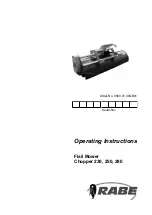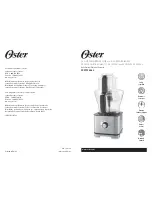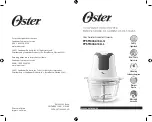
M
anual
F
ood
P
rocessing
e
quiPMent
3
ENGLISH
O
peratOr
’
s
M
anual
a
djuStmentS
1. Examine the pusher head fingers. If they are nicked or burred, smooth
the rough edges with a small flat file. The spaces between the fingers
must be uniform. Straighten any bent fingers.
2. Center the new blade assembly between bridge casting posts with the
sharp side facing the pusher head. Replace screws and rubber seals.
Be certain that the bottom blade fits between the two bottom-most
pusher head fingers.
3. Check the clearance between the pusher head fingers and blades. Make
sure they do not rest on or touch the blades at any point when you move
the head through its full travel. If there is contact, adjustments must be
made. Pusher head fingers must never contact blades.
Adjust the Pusher Head Assembly through the Blades:
1. Gently tap on the Pusher Head Assembly (A) so that the entire assembly
can pass through the blades. Notice how the “CIRCLED” portion (B) of
the pusher head assembly is now able to pass completely through the
blades. See Figure 1.
A
B
Figure 1. Pusher Head Adjustment Through the Blades.
To adjust Pusher Head Fingers between blades:
1. Carefully insert a screwdriver (B) between the slots in the Pusher Head
Assembly (A). Gently tap on the screwdriver (B)(up or down) to alter the
location of the Pusher Head Fingers so the slide effortlessly through the
blades. See Figure 2.
B
A
Figure 2. Pusher Head Adjustment Between the Blades.
NOTE:
Food acids will make blades dull and corrode the metal.
Always clean this food preparation equipment immediately
after every use.
P
reventative
m
aintenance
1. Clean the equipment after every use.
2. Keep proper blade tension.
3. Use for intended purposes only.
4. Change the blades regularly - based on usage.
r
ePlacing
B
lade
a
SSemBly
WARNING
Sharp Blade Hazard.
Blades are sharp and can cause cuts and
amputation.
To avoid injury from sharp blades, handle with caution. Only trained
personal should operate equipment or preform maintenance.
We suggest you change the complete assembly. Never mix old and new
blades in the same assembly as this may lead to excessive blade breakage.
Wash new blades with warm, soapy water and rinse thoroughly to remove
the thin protective oil film. Keep the sharp edge away from you when
handling blades.
1. Allow yourself ample room to work on a flat, dry surface. Familiarize
yourself with the parts diagram for your equipment. Blade assemblies
consist of blades, blade blocks, blade block pins, rubber seals, and
screws.
2. When changing blade assemblies on the Tomato King, close the pusher
head so that the pusher head fingers are through the blades resting
against the pin stop.
3. When changing blade assemblies on the Tomato Pro and Econo Pro
equipment, pull the pusher head assembly back away from the blades so
it is against the back stop.
4. To remove blade assemblies, use the proper tool to remove the four
blade block screws (2 at each end). Retain the rubber seals that are
mounted on the screws between the blade blocks and the casting.
5. Dispose of used blades and blade assemblies properly.






























